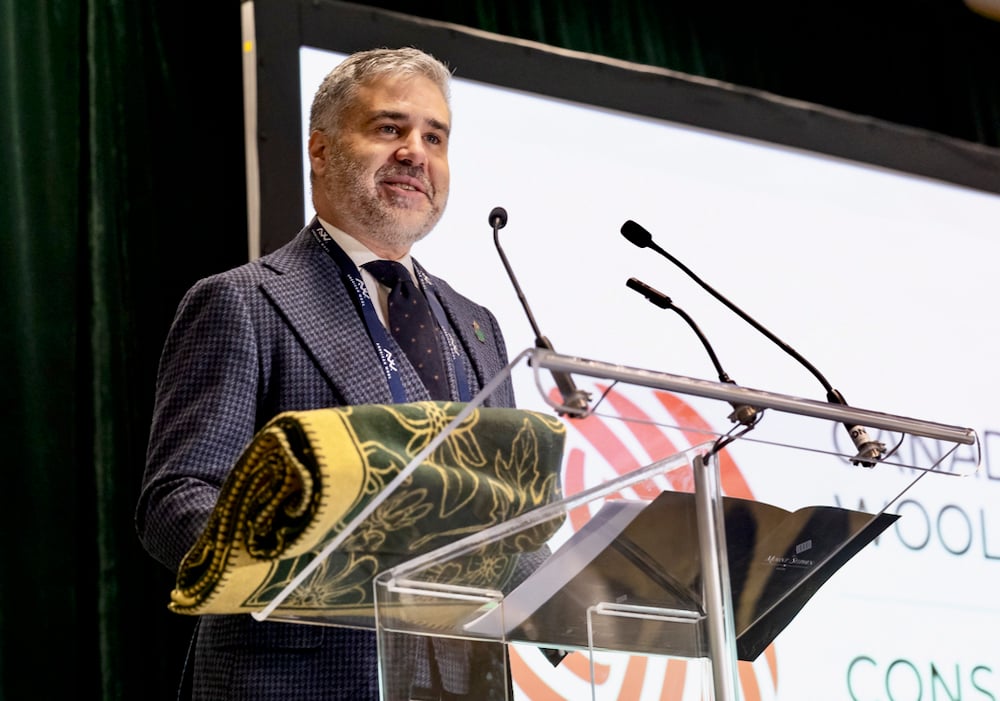Canadian wool weaves success story one fibre at a time

The Canadian Wool Council is getting a $185,000 federal funding boost over three years for branding and marketing through the AgriMarketing Program.
Read Also

Editorial: Greater collaboration is necessary
As a new year begins, it’s a time to reflect on what happened the previous year, and set goals for…
“It’s been a good couple of days for Canadian wool,” said Matthew Rowe, Campaign for Wool CEO, from the International Wool Symposium held in Montreal.
Why it matters: The financial potential of Canadian wool is gaining attention on the global market.
The world is noticing the value of Canada’s wool industry, said Rowe, through the high-end 100 per cent Canadian wool rugs gracing Canada’s global diplomatic offices and by hosting the International Wool Textile Organization annual convention within two years of gaining membership.
The new investment comes on the heels of a previous two-year federal funding program focused on developing, branding and marketing the upholstery and carpet plans for Canadian wool.
Campaign for Wool also launched the Fabric of Canada film series and courted the international convention. Its global table includes large production countries like China and Australia, as well as sub-national units like the Falkland Islands, but not Canada.
“We secured Canada’s first-ever seat in the history of the organization,” said Rowe.
“From becoming the newest member to becoming a very prominent member and then now hosting the world here in Canada, it’s been a bit of a whirlwind.”
The convention was a powerful stimulus for the Canadian industry and a coming-out party of sorts for Canadian wool to the world, Rowe added.
“Here in Montreal, at the global wool industry’s first-ever Canadian meeting, we are seeing the advantages of Canada sharing its agricultural, manufacturing, and design talents with the world,” said Brenda Shanahan, MP for Chateauguay-Lacolle, at the symposium.
Shanahan, who announced the funding on behalf of federal Minister of Agriculture and Agri-Food Lawrence MacAulay, said the investment will increase the CWC’s ability to amplify Canadian wool’s brand exposure and connection within the global industry.
“Our goal is to have a larger, more prosperous and profitable industry. We want farmers to get a better price at every step of the way,” said Rowe. “Because we’re representing the entire value chain, we want to create more opportunities in Canadian wool for manufacturers and designers.”
He said a second rug partnership with one of North America’s largest rug producers in British Columbia will marry 100 per cent Canadian wool rugs with designs by a hereditary Coast Salish chief featured in the Fabric of Canada series.
The conference included a presentation by North America’s largest suit manufacturer based in Montreal. Rowe said CFW pitched the idea for a 100 per cent Canadian wool tweed jacket, and the manufacturer spoke further on the proposition.
“It’s an amazing way of spreading the impact of this initiative and creating more high-value-added products, growing the market, the availability of products and the premium destination points for our fibre.”
Ontario Sheep Farmers and Alberta Lamb Producers, who represent the majority of Canada’s sheep producers, are equally invested in the initiative and applauded the federal government’s financial commitment.
Art Alblas, Ontario Sheep Farmers chair, said it will strengthen the wool sector and the CWC’s effort to build value in Canadian raised fibre.
Jordan Allen, Alberta Lamb Producers chair, said the investment, along with Campaign for Wool’s branding and marketing strategy, will provide Canadian sheep producers with more benefits and opportunities to realize the value of their wool in the market.
“Wool pelleting is a big thing in Alberta and becoming bigger, or using (wool) as bedding or alternative uses like insulation in barns because there isn’t a lot of other avenues,” said Allen.
She said she hoped the funding will encourage further development of processing facilities.
“We don’t have the processing facilities that are large enough to deal with the amount of wool we have in the province,” she said. “Not that this funding is going to all of a sudden magically bring a processing facility, but I’m hoping it’ll open up avenues for that.”
Allen said the conference provided information and inspiration she was eager to share with members.
Rowe said the CWC and Campaign for Wool are building an industry where people can make a good living and be proud of what they produce.
“Because, of course, wool is a natural, sustainable, biodegradable (product),” said Rowe. “This is something that’s going to be good for our economy, but also for the planet.”
Source: Farmtario.com

